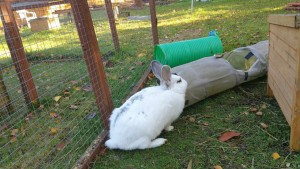Getting to know your rabbit
So you are now the owner of a rabbit or two, as previously mentioned in our April blog your rabbit will do better and be more stable if they are part of a pair or small group. There are a number of behaviours that are good to understand about your cute cuddly fluff ball.
Hostility: remember your new friend is a prey animal and will be fearful of any newcomers to their surroundings. If they are normally placid and when you approach their behaviour is unwelcoming, a check-up with the vet to ensure there is no pain or underlying medical condition that is causing the reactions.
We all like our own space and protect our home, rabbits are equally territorial, in the wild a rabbit group has a leader, usually a dominant male. If a new rabbit is introduced into another’s home ground and there is an aggressive response from the other rabbit, he is likely to be defending his territory. Neutral ground is always a good start when introducing your furry friends. Seek advice from rabbit rescue or vet services to support good interaction between your rabbits.
Chasing: rabbits run after each other to display their dominance, disputes like in any social group may occur, this is normal, it is important to give rabbits plenty of hutch and run space. A minimum of 6ft by 2ft hutches are recommended with additional run space. Not enough space can lead to unhappy bunnies and fights. Most fights are reported to be between unneutered males, one good reason to have your bunnies neutered.
Female rabbits can exhibit aggression, usually around their food bowls or in the wild nesting areas. Bunny owners may hear grunting or head butting toward their owner. This could be fear, related to bunnies’ natural prey instinct or previous negative experiences
You need to take time to get to know your bunny, wait for them to come to you, they need to see the hand as a friend. You could offer treats as the rabbit approaches you, fresh herbs e.g., parsley, mint, and coriander are best.
More bunnies: well, you know the saying, don’t you? Rabbits can breed from 10 -12 weeks, and a female can give birth every 4 weeks, that’s a lot of bunnies. It is better to see a vet and book them in for a neuter. This allows them to enjoy the companionship of other rabbit friends without pregnancy concerns.
Ill-health: taking the time to monitor your rabbit’s normal eating, drinking, pooping and playtime behaviour can help you know when something is not quite right. Rabbits are good at hiding when they are not well, so if your rabbit’s behaviour changes e.g. they don’t come out and see you at feed time, you need to look further.
You need to ask yourself, is your rabbit being less active? are they looking uncomfortable? Have they stopped eating? are there fewer droppings or watery droppings? Is there excess mucus on their front paws? Are they scratching around the ears all the time? or has your rabbit developed a head tilt? If you are noticing any of these changes a visit to the vet or chat with the veterinary nurse would be advised.
Lack of occupation: your bunny can become stressed and frustrated if they are bored. You may notice constant nibbling of cage bars, digging, and chewing. Improve the environment by creating foraging boxes to support food finding and digging, providing a choice of shelters from cardboard boxes to tunnels. Chew toys can encourage normalized play activity, willow tunnels, acorns, a range of sticks
Summary:
So this cute ball of fluff has to be handled with care, think carefully about its environment and run space. Give thought to who their companions are. Remember rabbits hide their illness well so monitor water intake, and food intake, remember diet should be 80% hay 10% pellets and 10% greens daily. Hay at all times. Look for changes in behaviour and try to understand them, modify your approach, and add enrichments to their living area, this may help. No rabbit is the same, what works for one may not work to settle your rabbit immediately. Don’t give up, trying to understand your bunny and what their body language is saying will create a stronger bond between you and a happier home for all. Look out for the next blog where we will explore small furry first aid remedies.
Reference:
Understanding Your Rabbits Habits:2011, Tamsin Stone




 07758 317569
07758 317569
